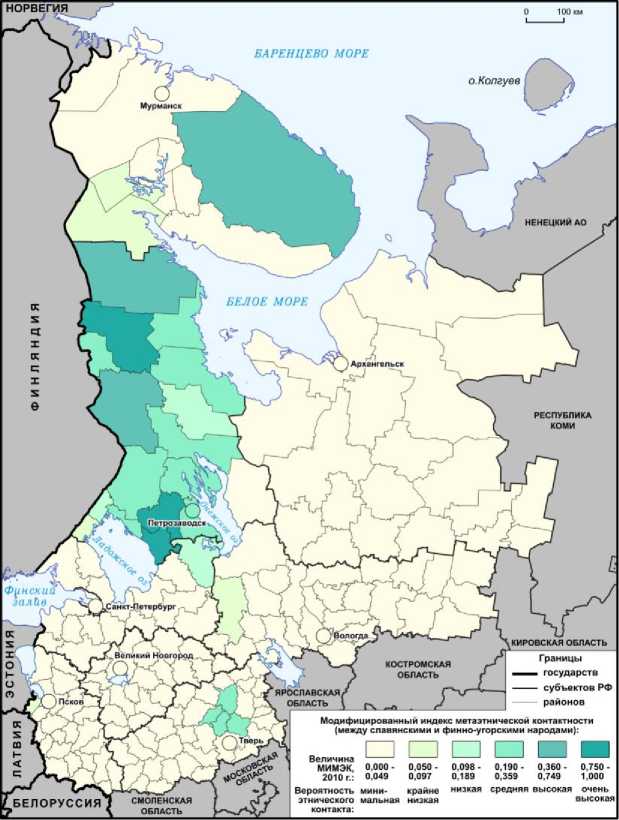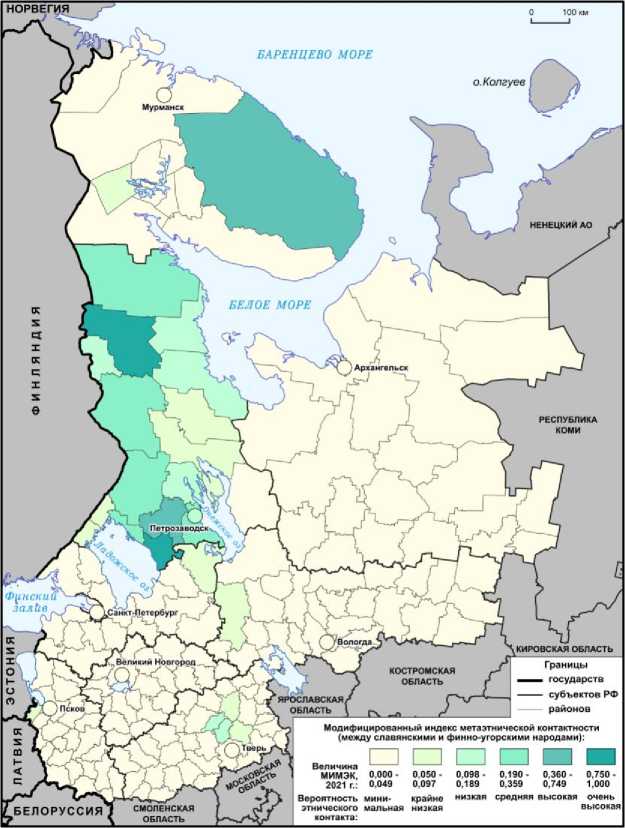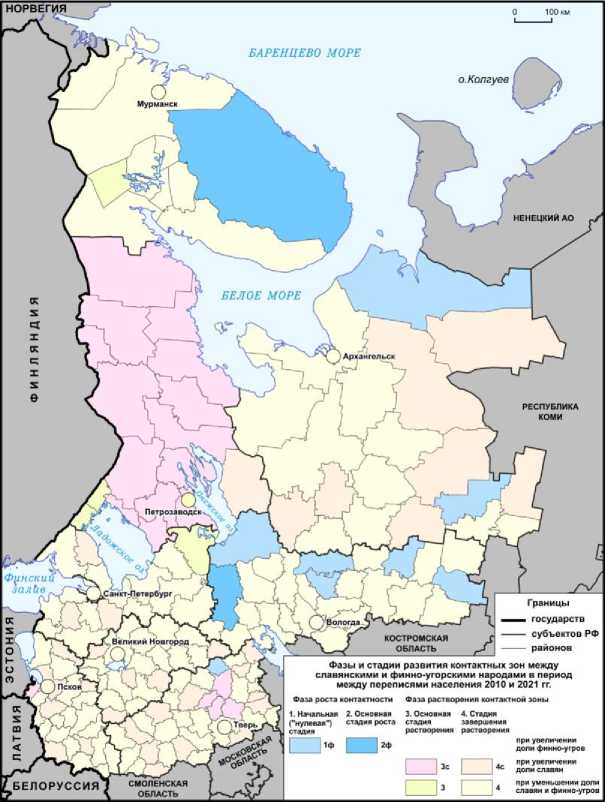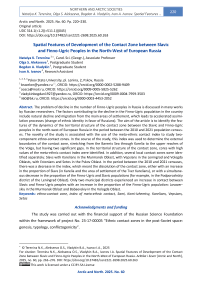Spatial Features of Development of the Contact Zone between Slavic and Finno-Ugric Peoples in the North-West of European Russia
Автор: Terenina N.K., Alekseeva O.S., Vladykin B.A., Ivanov I.A.
Журнал: Arctic and North @arctic-and-north
Рубрика: Northern and arctic societies
Статья в выпуске: 60, 2025 года.
Бесплатный доступ
The problem of decline in the number of Finno-Ugric peoples in Russia is discussed in many works by Russian researchers. The factors contributing to the decline in the Finno-Ugric population in the country include natural decline and migration from the main areas of settlement, which leads to accelerated assimilation processes (change of ethnic identity in favor of Russians). The aim of the article is to identify the features of the dynamics of the territorial structure of the contact zone between the Slavic and Finno-Ugric peoples in the north-west of European Russia in the period between the 2010 and 2021 population censuses. The novelty of the study is associated with the use of the meta-ethnic contact index to study two-component ethno-contact zones. In the course of the study, this index was used to determine the external boundaries of the contact zone, stretching from the Barents Sea through Karelia to the upper reaches of the Volga, but having two significant gaps. In the territorial structure of the contact zone, cores with high values of the meta-ethnic contact index were identified. In addition, several local contact zones were identified separately: Slavs with Karelians in the Murmansk Oblast, with Vepsians in the Leningrad and Vologda Oblasts, with Estonians and Setos in the Pskov Oblast. In the period between the 2010 and 2021 censuses, there was a decrease in the index, which meant the dissolution of the contact zone, either with an increase in the proportion of Slavs (in Karelia and the area of settlement of the Tver Karelians), or with a simultaneous decrease in the proportion of the Finno-Ugric and Slavic populations (for example, in the Podporozhskiy district of the Leningrad Oblast). Only two municipal districts experienced an increase in contact between Slavic and Finno-Ugric peoples with an increase in the proportion of the Finno-Ugric population: Lovozerskiy in the Murmansk Oblast and Babaevskiy in the Vologda Oblast.
Ethno-contact zone, index of meta-ethnic contact, Sami, Komi-Izhemtsy, Karelians, Vepsians, Setos
Короткий адрес: https://sciup.org/148331900
IDR: 148331900 | УДК: 314.1(=1.2)(=511.1))(045) | DOI: 10.37482/issn2221-2698.2025.60.263
Текст научной статьи Spatial Features of Development of the Contact Zone between Slavic and Finno-Ugric Peoples in the North-West of European Russia
DOI:
Russian researchers often address the issue of the decline in the population of Finno-Ugric peoples in Russia. The most frequently cited factors influencing the dynamics of the Finno-Ugric population in Russia include natural decline, migration outflow from areas of compact settlement of peoples and acceleration of assimilation processes in recent decades (change of ethnic identity in favor of Russians). At the same time, the results of each new population census indicate a gradual erosion of traditional areas of settlement of Finno-Ugric peoples in the north-west of the European part of the country.
This study is based on methods developed within the framework of the concept of ethnocontact zones. Ethno-contact zones (ECZ) are considered as elements of geo-cultural (ethnocultural) space, resulting from the overlap of two or more ethnic systems. ECZs have a certain vertical (ratio of ethnic groups) and horizontal (territorial) structure.
The aim of the study is to identify the dynamics of the territorial structure of the contact zone between the Slavic peoples of the Indo-European family (mainly Russians, Belarusians and Ukrainians) and the Finno-Ugric peoples of the Uralic family (Sami, Karelians, Vepsians, Setos, etc.) in the north-west of European Russia in the period between the 2010 and 2021 population censuses.
The study region covers eight constituent entities of the Russian Federation located in the western part of the Northwestern Federal District (the Republic of Karelia, St. Petersburg, Leningrad, Pskov, Novgorod, Vologda, Murmansk Oblasts and the Arkhangelsk Oblast without the Nenets Autonomous Okrug), as well as the Tver Oblast due to the presence of the Upper Volga (Tver) Karelians living there.
The information base of the study is ethnic statistics at the municipal level based on the results of the 2010 and 2021 censuses, presented on the website of the Federal State Statistics Service 1. Data from the websites of Rosstat’s regional branches were also used.
Initial presuppositions
The demographic dynamics of the Finno-Ugric peoples of Russia is the research topic of a number of works by Russian authors [1, Loginova N.N., Rebrova T.P., pp. 89–97; 2, Loginova N.N., Kildishova N.A., Semina I.A. et al., pp. 7–20]. In particular, some publications compare ethnodemographic processes among the Finno-Ugric population of Russia and foreign countries [3, Myasnikova A.B., pp. 96–101; 4, Molchanova E.V., pp. 759–779; 5, Molchanova E.V., pp. 2180–2188]. In this regard, attention is drawn to the role of ethnic mobilization in the development of the Finno-Ugric peoples [6, Nesterova N.A., pp. 365–375; 7, Strogalshchikova Z.I., pp. 17–24].
Changes in the number and settlement of the Baltic-Finnish peoples living in the northwest of the country are discussed in publications [8, Manakov A.G., Bocharnikova A.V., Terenina N.K., pp. 49–69; 9, Manakov A.G., Terenina N.K., pp. 96–107], and modern ethnic processes
Natalya K. Terenina, Olga S. Alekseeva, Bogdan A. Vladykin, Ivan A. Ivanov. Spatial Features … among the Tver Karelians are examined in [10, Krivonogov V.P., pp. 109–123], issues of ethnic selfidentification of the Karelians of Karelia and the Tver Oblast are reviewed in articles [11, Klementyev E.I., pp. 144–152; 12, Kalinina S.O., pp. 191–195]. It is also necessary to pay attention to the works devoted to the dynamics of the Finno-Ugric population of the Kola Peninsula, represented by the Sami [13, Klokov K.B., Khrushchev S.A., pp. 39–51] and the Komi-Izhemtsy [14, Krivonogov V.P., pp. 117–124].
Research methodology
The research methodology is based on the ethnic mosaic index [15, Eckel B.M., pp. 47–63], referred to in Western science as the ethnolinguistic or ethnic fractionalization index [16, Greenberg J.H., pp. 109–115; 17, Ziller C., pp. 1211–1240], or more precisely, on its modified analogue calculated for two-component ethnic systems. One of the shortcomings of the ethnic mosaic index (EMI) is the undefined upper limit of its values. S.A. Gorokhov proposed to normalize the EMI by bringing its values to the range from zero to one [18, pp. 56–61]. The EMI is equal to zero if representatives of only one ethnic group live in a country or region. In this case, the index calculated using S.A. Gorokhov’s modified EMI reaches one when the ratios of two or more ethnic groups are equal.
Previously, we proposed a version of the EMI calculated for two-component ethnic systems [19, Terenina N.K., pp. 101–116; 20, Ivanov I.A., Manakov A.G., Terenina N.K., pp. 116–129]. It was designated as the ethnic contact index (ECI). This article uses a modified analogue of the ECI, the values of which range from zero to one. The formula for calculating the modified ECI (ME-CI) is as follows: MIEC= k *4* P A * P B (where P A is the proportion of representatives of ethnic group A in a certain territory; P B is the proportion of representatives of ethnic group B in the same territory; k is the correction coefficient characterizing the “interethnic distances” [21, Soroko E.L., pp. 96–123; 22, Soroko E., pp. 012035], which we propose to call the ethnic contrast coefficient (ECC), or the Soroko coefficient).
However, in this article, the object of study is the contact zone not between two peoples, but between two groups of ethnic groups (meta-ethnic groups). On the one hand, these are the Slavic peoples, including Russians, Belarusians and Ukrainians, on the other hand, the Finno-Ugric peoples, including the Sami, Karelians, Tver Karelians, Vepsians, Izhorians, Setos and other representatives of the Finno-Ugric group of the Uralic language family. Therefore, it was proposed to call the indicator used in the work the modified index of meta-ethnic contact (MIMEC).
EMI is used in ethnic geography both for comparative analysis of ethnic heterogeneity of territories and for determining the external boundaries of ethno-contact zones and assessing the degree of their expression [23, Lysenko A.V., Vodopyanova D.S., Azanov D.S., pp. 165–170; 24, Lysenko A.V., Azanov D.S., Vodopyanova D.S., pp. 130–137]. MIMEC performs a similar function, and therefore it is important to determine the MIMEC scale used to solve this problem. This article uses the MIMEC scale (0.0495; 0.0975; 0.19; 0.36; 0.75; 1.0), the interpretation of which is as fol- lows. Provided that two meta-ethnic groups together make up 100% of the population (which, however, is a rare phenomenon), the ratio of representatives of meta-ethnic groups will be as follows: 1.25 to 98.75%, 2.5 to 97.5%, 5 to 95%, 10 to 90%, 25 to 75%, 50 to 50%, respectively.
The MIMEC value can characterize the probability of contact between the Slavic and Finno-Ugric populations of the territories under consideration. Taking into account the weak expression of modern ECZ in the north-west of European Russia, it is proposed to classify the territories where the MIMEC value exceeds 0.0975 as the contact zone between the Slavic and Finno-Ugric peoples. With MIMEC values from 0.0975 to 0.19, we can talk about weakly expressed ECZ, MIMEC from 0.19 to 0.36 — ECZ of average expression, MIMEC from 0.36 to 0.75 — clearly expressed ECZ, MIMEC from 0.75 to 1.0 — the most clearly expressed ECZ. The proposed additional MIMEC mark of 0.0495 makes it possible to trace on the map local ECZ, which can still be identified at the level of rural settlements and volosts, but have actually lost the status of ECZ at a higher hierarchical level.
The methodology for analyzing the dynamics of the territorial structure of the contact zone between the Slavic and Finno-Ugric peoples is based on the change in the value of the MIMEC and the share of meta-ethnic groups. It should be noted that the change in the ethnic mosaic index (or ethnic fractionalization index) and its analogues is used to study the dynamics of ethnic heterogeneity of the population of countries and regions both in foreign science [17, Ziller C., pp. 1211– 1240; 25, Dražanová L.; 26, Dražanová L.] and in Russian studies [27, Manakov A.G., pp. 33–52; 28, Manakov A.G., Andreev A.A., Ivanov I.A., Pavlova K.V., pp. 70–81; 29, Manakov A.G., Sidorovich A.A., Ivanov I.A., pp. 3–23]. At the same time, there is experience in mapping changes in the index over different time intervals at the level of lower administrative-territorial entities [19, Terenina N.K., pp. 101–116; 20, Ivanov I.A., Manakov A.G., Terenina N.K., pp. 116–129; 30, Németh B.].
We proposed a methodology for analyzing the dynamics of two-component ethno-contact zones by identifying phases and stages of ECZ development [20, Ivanov I.A., Manakov A.G., Terenina N.K., pp. 116–129]. Thus, two phases of ECZ development are distinguished, each of which includes two stages. The boundary of the first phase of ECZ development (“growth of contact” with an increase in MIMEC) and the second phase (“dissolution of ECZ” with a decrease in MIMEC) is the maximum value of MIMEC, equal to 1.0. The first phase is divided into the initial (“zero”) stage, corresponding to the embryonic state of ECZ, and the main stage of contact growth, when the ECZ develops steadily. The second phase is divided into the main stage of ECZ dissolution and, separately, the final stage of dissolution, when the territory actually loses its ECZ status, but the inertia of the decrease in ethnic contact, set in the previous stage, is preserved.
Results and discussion
The contact zone between the Slavic and Finno-Ugric peoples in the north-west of European Russia in 2010 (Fig. 1), if we take MIMEC=0.0975 as the criterion for determining the external boundaries of the contact zone, covered the Lovozerskiy district of the Murmansk Oblast, almost all municipalities of Karelia (except for the Pudozhskiy district in the south-east and Lakhdenpokh-skiy district in the south-west), the Podporozhskiy district of the Leningrad Oblast and four districts of the Tver Oblast (Likhoslavlskiy, Maksatikhinskiy, Spirovskiy and Rameshkovskiy). The most pronounced ECZs were three municipal districts of the Republic of Karelia — Kalevalskiy, Olonetskiy and Pryazhinskiy, with the Olonetskiy district being the only one in north-western European Russia with a preponderance of the Finno-Ugric population over the Slavic in 2010 (54% to 44.5%). It is also worth noting the Lovozerskiy district in the Murmansk Oblast, which can be considered as a pronounced ECZ. The specificity of this contact zone is related to the fact that its Finno-Ugric component was represented by two peoples — the Sami and the Komi-Izhemtsy, with a numerical preponderance of the latter (1,081 Komi-Izhemtsy to 906 Sami in 2010).

Fig. 1. Territorial structure of the contact zone between the Slavic and Finno-Ugric peoples in the north-west of European Russia according to the 2010 census. The MIMEC values are indicated by color 2.
The ECZs indicated above serve as the cores of the territorial structure of the contact zone between the Slavic and Finno-Ugric peoples in the north-west of European Russia. This contact zone stretches as a belt (with two significant gaps) from north to south — from the Kola Peninsula through Karelia to the area of settlement of the Tver Karelians in the upper reaches of the Volga.
-
2 Compiled by Ivanov I.A., legend is developed by Terenina N.K.
In the two main gaps in the contact zone, there were local ECZs (within municipal formations with MIMEC = 0.0495 and above): Slavs with Karelians in the Kovdorskiy and Kandalaksha districts of the Murmansk Oblast, as well as Slavs with Vepsians in the Babaevskiy district of the Vologda Oblast. Separately from the main belt of the contact zone between the Slavic and Finno-Ugric peoples, a local ECZ was preserved in the Russian-Estonian borderland — Russians with Estonians and Setos in the Pechora district of the Pskov Oblast. The dynamics of this local ECZ are described in detail in the article [8, Manakov A.G., Bocharnikova A.V., Terenina N.K., pp. 49–69].
In the period between the 2010 and 2021 population censuses, the Finno-Ugric population in north-western European Russia decreased from 106.7 to 57.4 thousand people, i.e. by 46.2%, but the number of the Slavic population also decreased significantly — from 11.4 to 10.8 million people, i.e. by 5.2%. However, it should be noted that the 2021 census was characterized by a high proportion of the population who did not indicate their nationality. Nevertheless, if we consider the share of the Slavic and Finno-Ugric population from the number of those who indicated their nationality, then from 2010 to 2021 the share of Slavs decreased from 95.62% to 93.83%, while the Finno-Ugric population — from 0.9% to 0.5%.
The 2021 census revealed a significant erosion of the contact zone between the Slavic and Finno-Ugric peoples in the north-west of European Russia (Fig. 2). Only the core areas of the contact zone remained relatively stable, although the Olonetskiy district lost the preponderance of the Finno-Ugric peoples over the Slavic ones, the ratio of which began to be 41% to 57%. The degree of expression of the ECZ around the cores of the contact zone sharply decreased, the gaps between its three main parts became even more noticeable. The local ECZs of the Slavs with the Karelians in the Murmansk Oblast almost completely dissolved, the local ECZs of the Slavs with the Vepsians in the Leningrad Oblast (Podporozhskiy district) and with the Upper Volga Karelians in the Tver Oblast lowered their status.

Fig. 2. Territorial structure of the contact zone between the Slavic and Finno-Ugric peoples in the north-west of European Russia according to the 2021 census. The MIMEC values are indicated by color 3.
Thus, the changes in the territorial structure of the contact zone between the Slavic and Finno-Ugric peoples in the northwest of European Russia that occurred between the All-Russian Population Censuses of 2010 and 2021 can be traced even by the two maps proposed above, but the dynamics of the contact zone are best seen on the map, which reflects the phases and stages of the development of the ECZ during this period, also taking into account the change in the share of the Slavic and Finno-Ugric population (Fig. 3).
-
3 Compiled by Ivanov I.A., legend is developed by Terenina N.K.

Fig. 3. Changes in the territorial structure of the contact zone between the Slavic and Finno-Ugric peoples between the 2010 and 2021 censuses. Phases and stages of development of contact zones are indicated by color 4.
In the period from 2010 to 2021, the dominant trend in the change in the degree of contact between the Slavic and Finno-Ugric peoples outside the main belt of the Slavic-Finno-Ugric ECZ in the north-west of European Russia was a decrease in contact with an increase in the proportion of Slavs (type 4c) or a decrease in the share of both the Slavic and Finno-Ugric populations (type 4). There were also isolated municipalities where the share of Finno-Ugric peoples increased (type 1f), although most often this was not due to an increase in the Finno-Ugric population, but because of its decrease to a slightly lesser extent than the Slavic population. Therefore, these municipalities can hardly be considered territories where new Slavic-Finno-Ugric ECZs were emerging.
Within the contact zone between the Slavic and Finno-Ugric peoples in the north-west of European Russia, there was also a decline in contact, or more precisely, the dissolution of the ECZ with an increase in the proportion of Slavs (type 3c) or a decrease in the proportion of the Slavic and Finno-Ugric population (type 3). Almost the entire territory of Karelia and the area of settlement of the Tver Karelians were in the main stage of dissolution of the ECZ with an increase in the proportion of Slavs. The number of Karelians in the territory of the four districts of the Tver Oblast mentioned above decreased by 3.3 thousand, or almost two-thirds. Only two municipal districts
-
4 Compiled by Ivanov I.A., legend is developed by Terenina N.K.
Natalya K. Terenina, Olga S. Alekseeva, Bogdan A. Vladykin, Ivan A. Ivanov. Spatial Features … within the main belt of the contact zone experienced an increase in contact between Slavic and Finno-Ugric peoples with an increase in the share of the Finno-Ugric population (type 2f) — Lovoz-erskiy in the Murmansk Oblast (although the number of Komi-Izhemtsy and Sami decreased slightly there) and Babaevskiy district in the Vologda Oblast (where the number of Vepsians increased noticeably, which is most likely a consequence of the ethnic re-identification of part of the population).
For comparison, it should be noted that the contact zone between Slavic and Finno-Ugric peoples in the north-east and east of European Russia is currently more pronounced, in particular, in the Komi Republic, as well as in the Finno-Ugric republics of the Ural-Volga region. Although in the second decade of the 21st century, the dissolution of the contact zone in favor of the Slavic population dominated here as well, there were more territories where the share of the Finno-Ugric population was growing, and in a number of municipalities of the republics of Mari El and Mordovia, the dissolution of contact zones in favor of the titular peoples was even observed.
Conclusions
In the course of the study, the external boundaries of the contact zone between the Slavic and Finno-Ugric peoples in the north-western part of European Russia were determined using the meta-ethnic contact index. The contact zone stretches as a belt from north to south — from the Barents Sea through Karelia to the upper reaches of the Volga, but has two significant gaps between the areas of settlement of the Finno-Ugric peoples (the Sami and Komi-Izhemtsy) on the Kola Peninsula, the Karelians and Vepsians in the middle part of the contact zone and the Tver Karelians in its southern part. The territorial structure of the contact zone includes cores with high contact index values between the Slavic and Finno-Ugric populations. In addition, a number of local contact zones between Slavic and Finno-Ugric peoples were considered separately: Karelians in the Murmansk Oblast, Vepsians in the Leningrad and Vologda Oblasts, Estonians and Setos in the Pskov Oblast.
In the period between the 2010 and 2021 population censuses, a decrease in the metaethnic contact index was observed within the boundaries of the identified contact zone, which meant the dissolution of the contact zone either due to an increase in the proportion of Slavs (in Karelia and the area of settlement of the Tver Karelians) or a simultaneous decrease in the proportion of the Finno-Ugric and Slavic populations (for example, in the Podporozhskiy district of the Leningrad Oblast). Only two municipal districts within the main contact zone experienced an increase in contact between Slavic and Finno-Ugric peoples with an increase in the share of the Finno-Ugric population — Lovozerskiy district in the Murmansk Oblast (although the number of Sami and Komi-Izhemtsy decreased slightly there) and Babaevskiy district in the Vologda Oblast (where the number of Vepsians increased noticeably).
Outside the main belt of the contact zone in the north-west of European Russia, the share of Slavs also increased or the proportion of both Slavic and Finno-Ugric peoples decreased, which in general led to a decrease in the degree of contact between these two population groups. However, there were isolated municipalities, where the proportion of Finno-Ugric peoples increased, although this was most often due not to an increase in the Finno-Ugric population, but to its decline at a slightly slower rate than that of the Slavs.


